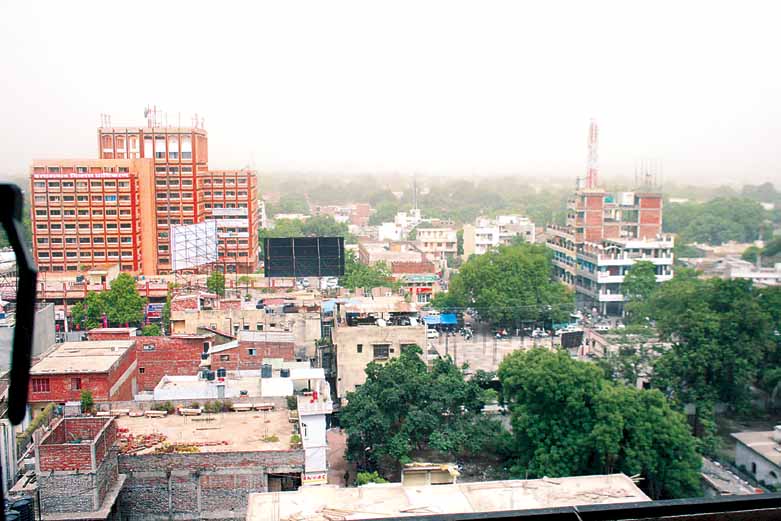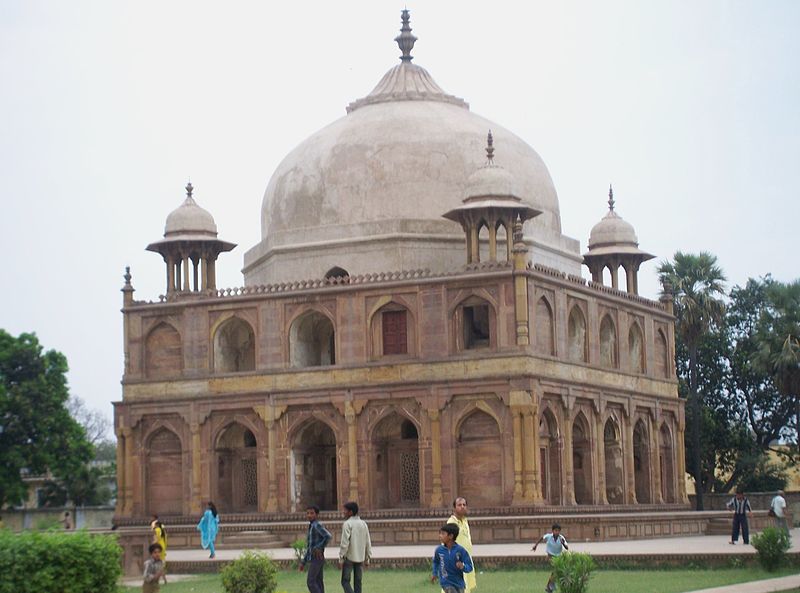A visit to Sangam Nagri - Allahabad , Uttar Pradesh
| two holy rivers Ganges and Yamuna meet. |
List
1) Triveni Sangam
Type - Water body
Period -
Description - It is the "confluence" of two physical rivers Ganges, Yamuna, and the invisible or mythic Saraswati. It is a place of religious importance and the site for historic Kumbh Mela held every 12 years.
2) Alfred Park
Type - Park
Period - 1931
Description - Also known as Chandrashekhar Azad Park and Company Garden it is a public park of 133 acres area and is the biggest park in Allahabad.[1] It is renamed after freedom fighter Chandra Shekhar Azad, who sacrificed his life here, during the Indian independence struggle in 1931.
3) All Saints Cathedral
Type - Church
Period - 1887
Description - A noted Anglican Cathedral in Allahabad.It is an example of 13th-century Gothic style buildings in Asia built by the British during their rule in India. In 1871 AD, British architect Sir William Emerson, architect of Victoria Memorial, Kolkata, designed this monument. It was consecrated in 1887.
4) Allahabad Fort
Type - Fort
Period -
Description - Allahabad Fort was built by Emperor Ashoka but repaired by Emperor Akbar in 1583. The fort stands on the banks of the Yamuna near the confluence with the river Ganges. It is the largest fort built by Akbar. In its prime, the fort was unrivaled for its design, construction and craftsmanship. This huge fort has three galleries flanked by high towers.
5) Allahabad High Court
Type - High Court
Period - 1869
Description - A fine example of Georgian architecture, it was one of the first high courts to be established in India.
6) Allahabad Museum
Type - Museum
Period - 1931
Description - Established in 1931, it is known for its rich collection and unique objects of art, and is funded by Ministry of Culture.
7) Allahabad University

Type - University
Period - 1887
Description - One of the oldest universities established in the Indian subcontinent. Its origins lie in the Muir Central College, named after Lt. Governor of North-Western Provinces, Sir William Muir in 1876, who suggested the idea of a Central University at Allahabad, which later evolved to the present university.[6][7] At one point it was called the "Oxford of the East",[8]
8) Anand Bhavan
Type - Museum
Period - 1930
Description - Anand Bhavan is a large bungalow in Allahabad which has been turned into museum. It was constructed by Indian political leader Motilal Nehru in the 1930s to serve as the new residence of the Nehru family when the original mansion Swaraj Bhavan was transformed into the local headquarters of the Indian National Congress.
9) Civil Lines
Type - Area
Period - 19th Century
Description - Formerly known as Cannington[9] it is the central business district of Allahabad, and is famous for its urban setting, gridiron plan roads[10] and high rise buildings. The area was built by the British during the heyday of the British Raj and was a residential colony of the British at that time. The present day Civil Lines has several skyscrapers and modern buildings which show the constant change taking place in the city
10) Jawahar Planetarium
Type - Planetarium
Period - 1979
Description - The planetarium was built in 1979 and is situated beside Anand Bhavan, the former residence of the Nehru-Gandhi family. It is managed by the 'Jawaharlal Nehru Memorial Fund' (estb. 1964), which has its headquarters at Teen Murti House, New Delhi.[11]
11) Khusro Bagh
Type - Garden
Period - 18th Century
Description - It is a large walled mughal garden surrounding the mausoleums of Khusrau Mirza(died 1622), eldest son of emperor Jahangir, Shah Begum, Khusrau's mother (died 1604), a Rajput princess and Jahangir's first wife, and that of Princess Sultan Nithar Begam (died c.1624), Khusrau's sister.[12] It presents an exquisite example of Mughal architecture
12) Kumbh Mela
Type - Festival
Period -
Description - It is a mass Hindu pilgrimage of faith in which Hindus gather to bathe in a sacred river. It is considered to be largest peaceful gathering in the world with over 100 million people visiting during the Maha Kumbh Mela in 2013.[13]
13) Mayo Memorial Hall
Type - Meeting Hall
Period - 1879
Description - A large meeting hall in Allahabad, situated near the Thornhill Mayne Memorial, was meant for public meetings, balls and receptions in commemoration of the assassinated Viceroy.[14] Mayo Memorial Hall was designed by Richard Roskell Bayneand was completed in 1879.[15
14) Minto Park
Type - Park
Period - 19th Century
Description - The park is a historical site for in 1858 Earl Canning read out the declaration of Queen Victoria's Proclamation which resulted in the complete transfer of control over Indiafrom The East India Company to the government of Britain.[16][17]
15) New Yamuna Bridge
Type - Cable Bridge
Period - 2004
Description - It is the longest cable-stayed bridge of India, located in Allahabad[18][19][20] The bridge was constructed by the end of 2004 with the aim of minimizing the traffic over the Old Naini Bridge.[21] The bridge runs North-South across the Yamuna river connecting the city of Allahabad to its neighborhood of Naini.
16) Ulta Qila
Type - Fort
Period - 1855
Description - This mound, on which Samudra Koop & Ulta Qila are located, is also known as ‘Kot’. A big walled well is located on the mound. It is believed that this ‘Samudra Koop’ is the one, which is aptly described in Matsya Puran & Padm Puran while archaeologists believe that it was built during the reign of Samudra Gupta hence this name. Till 1855, this area was in the form of a mound only but in the same year a Vaishnav saint Sudarshan Das from Ayodhya renovated the well and got an ashram & a temple built here. This area has big stairs on the Ganges side along with many caves. Five similar wells are found in Ujjain, Mathura, Allahabad, Varanasi & Patalpur also.
Harbenga, the local ruler was very cruel. He hatched the conspiracy of maligning the Sheikh Taqui Baba- a local saint. As a consequence of curses of baba, his evil designs boom ranged and his fort got topsiturveyed (Ulta Qila) and his set up was totally destroyed in a big fire, so the place came to be known as Jhulsi or Jhunsi. But according to some documents released by the Archaeological Department, this incidence happened due to the curses of Guru Gorakhnath, the disciple of Matseyndra Nath.
17) Swaraj Bhavan
Type - Mansion
Period - 19th Century
Description - A large mansion located in Allahabad which was owned by Indian political leader Motilal Nehru in the 19th century, it has served as the ancestral home of the Nehru-Gandhi Family — future Prime Minister of India Indira Gandhi was born there. The First Prime Minister of India Jawaharlal Nehru was however not born in Anand Bhawan.[22]
18) Thornhill Mayne Memorial
Type - Library
Period - 1878
Description - It is a public library situated at Alfred Park. Designed by Richard Roskell Bayne and completed in 1878, it is a remarkable example of Gothic Style.[15] It was opened as a memorial to the friendship of Lord Thornhill, the Commissioner of Allahabad and Mr. Mayne, the Collector. The monument has served as the house of legislative assembly in British era when Allahabad was the capital of United Provinces.























